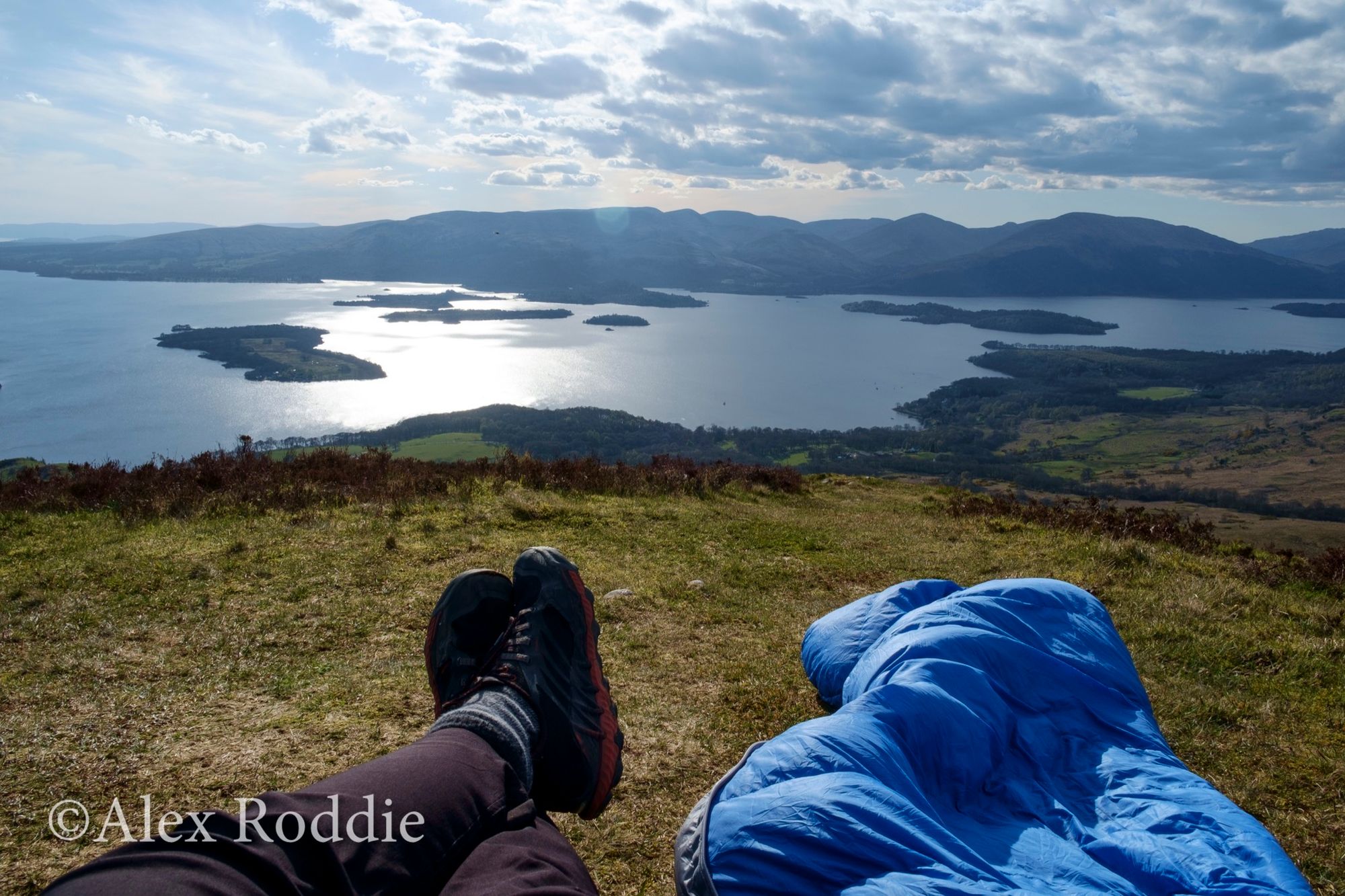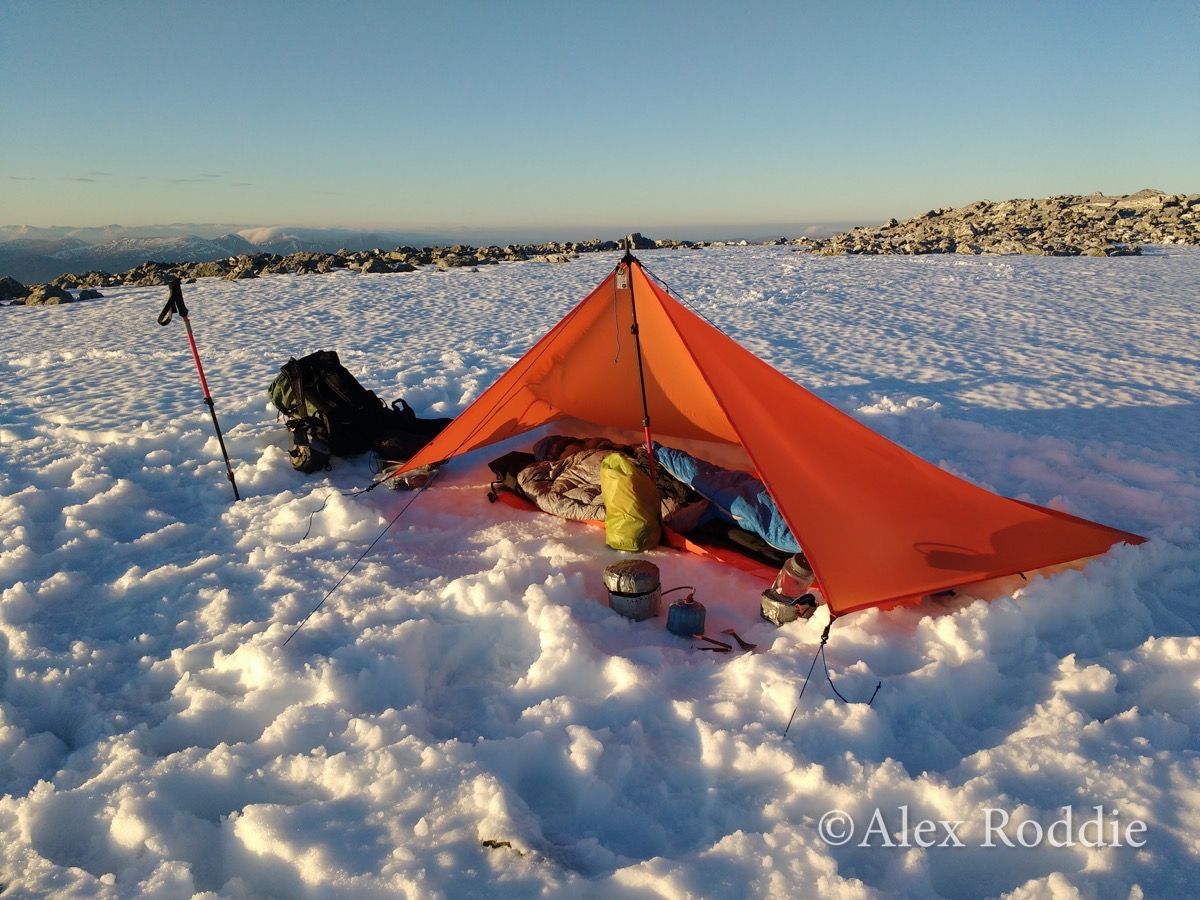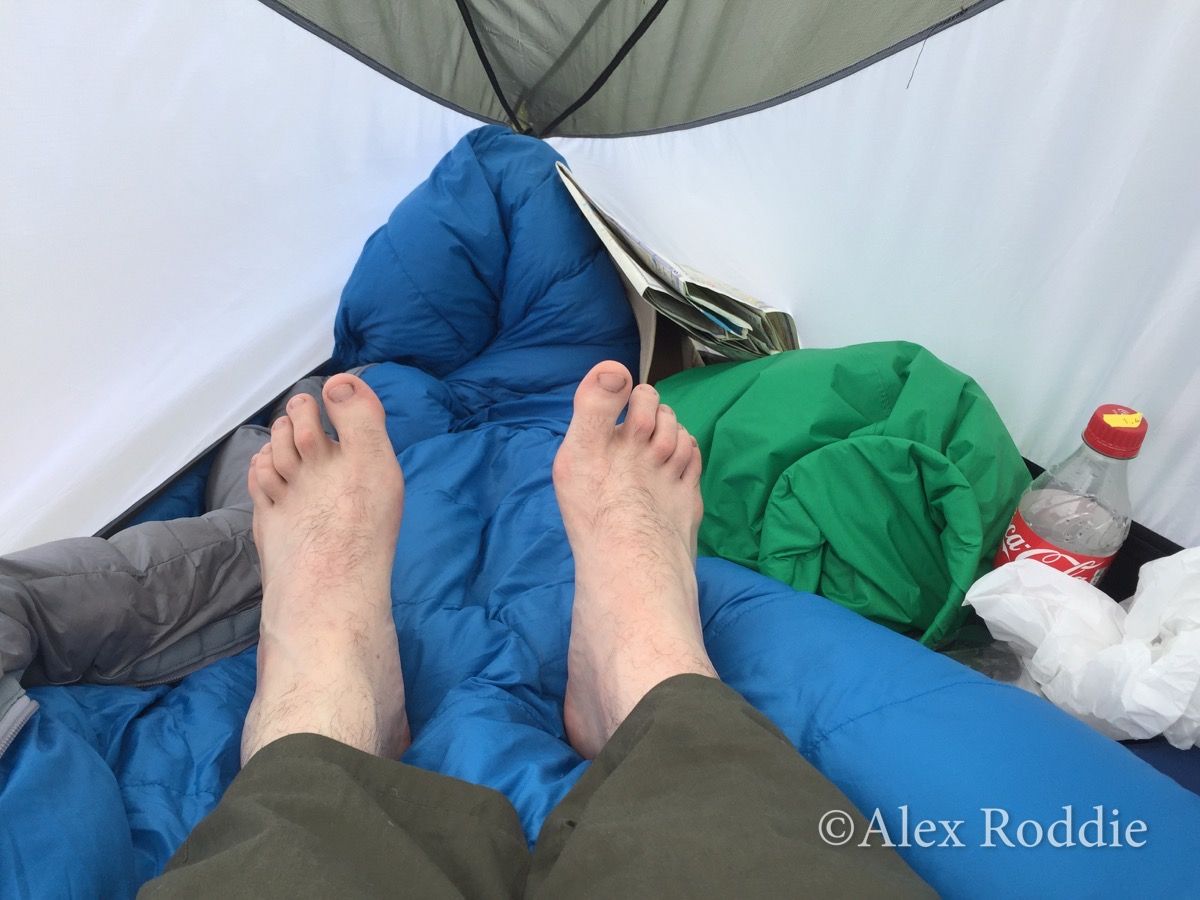Thoughts on summer sleep systems

Two years ago, I bought a new sleeping bag and thought it would be ideal for every backpacking scenario. But now I find my needs diversifying, and I’m looking for a new – and much lighter – option for summer trips.
The Rab Neutrino 400
The sleeping bag I bought in early 2015 is the Rab Neutrino 400. This isn’t a full review, but I have now used it a great deal so this is a good opportunity to run over the things I like and dislike about this bag. It’s worth noting that not all of these points relate to this bag specifically, but to down sleeping bags in general.
Pros:
- The stated temperature rating is 2.5˚C, but I have successfully used it several degrees lower than this and felt comfortable – without having to put on additional clothing. When coupled with an insulated jacket and warm socks, I can push it to about -4˚C with minimal discomfort.
- The 800-fill-power down is really high quality, and inflates well even after compression.
- It only weighs 805g. That’s not bad.
- The bag is very roomy. No problem adding extra clothing or a sleeping bag liner inside. I like the fact that the hood is really roomy, too.
Cons:
- After heavy use, the bag has developed cold spots and I have to spend more time than I would like manually rearranging the down within the baffles. To be honest, this is annoying1.
- A temperature rating of 2.5˚C is versatile, but it isn’t quite versatile enough for my needs. It’s great for perhaps 70% of the three-season backpacking I do, but last year I often found it a bit too warm, and ended up using it as a quilt. And it just isn’t warm enough to be a winter bag (although I have used it for a couple of winter trips in milder weather).
- 805g is light, but in the warmer months I can go much lighter.
- Although the bag is roomy, I still found myself constricted by it at times, and this led to tossing and turning overnight.
- Finally, after being used for maybe 70-80 nights over the last couple of years, the bag is dirty and needs cleaning – which is a delicate and time-consuming process2. When I used it last year in the Pyrenees, it was often very warm overnight and I found the down’s performance compromised by oils, sweat and dirt (maybe not nice to think about, but this is a major factor affecting sleeping bags for people who use them intensively).
- When the bag is dirty, the lining material can feel uncomfortable against bare skin.
So, the Rab Neutrino 400 is a good sleeping bag, but there’s only so much that one bag can achieve. Late last year, I realised that I needed to diversify. The first step was to buy a much warmer winter bag – my choice was the Enlightened Equipment Revelation 10, a winter quilt rated to -12˚C and only about 100g heavier than the Rab. This item will be the subject of a review when I’ve had a chance to test it more thoroughly, but so far I’ve used it for a couple of trips and am very satisfied with it.

But on to the main subject of this article. What to do about a summer bag? I want something lighter and with a less robust temperature rating. This time I will go for a quilt, not a bag; quilts are lighter, more versatile, and less restricting.
The synthetic option
Years ago, I had a one-season synthetic bag. It was made by Gelert, packed down to the size of a bread loaf, and was really light (maybe 400g). I recall paying about £20-£30 for it in 2004.
I really liked that sleeping bag. It was so light I could carry a complete bivy setup in a daypack, and often did just that. But the problem was what you might expect: it was freezing to actually sleep in unless the temperature was well in the teens. In June 2008, I bivouacked just beneath the summit of Ben Starav using that Gelert sleeping bag. It was a cold and uncomfortable night.
Nevertheless, I miss that sleeping bag and I have been looking for something similar, but with more warmth.
I’ve been looking at the As Tucas Sestrals quilt. These quilts are hand-made to order in Spain, designed by an experienced Pyrenean backpacker, and come highly recommended. I would go with the APEX 133 insulation option (rated to 5˚C) in Medium/Wide sizing.
Here are some of the benefits of going with the As Tucas option:
- The stated weight is 545g, a 260g saving over my current setup.
- It will be far better for backpacking in warm conditions.
- Combined with the ultralight bivy bag and insulated jacket I always carry anyway, I can certainly push it to 0˚C. And I rarely need to go lower than that for summer backpacking.
- Synthetic bags/quilts are less affected by moisture and dirt, and are much easier to care for. You can chuck them in the washing machine with no worries. This really appeals to me. I’d be able to use it without a silk liner for a longer period of time before the bag requires cleaning, too.
The down option
Great as the Sestrals quilt appears to be, there are some notable drawbacks with synthetic bags/quilts in general:
- Synthetic insulation is heavier and bulkier than down. And since I use a none-too-capacious ÜLA Circuit rucksack, pack space is just as important to me as pack weight.
- It is currently believed that synthetic insulation degrades and becomes less effective over a number of years. I have certainly noticed this affecting my oldest synthetic insulated jacket, which I bought in 2009 and is nowhere near as warm now.
- While synthetic insulation is a little more robust in terms of damp weather and resisting dirt, down technology has improved a great deal. There are certainly no drawbacks to using down insulation in wet climates if you take basic precautions (and I have years of practice in doing just this).
So, given these facts, it would be stupid to disregard down. And I have found a down option that looks very appealing.

I like my Enlightened Equipment Revelation 10, and I found it interesting that you can configure a much lighter option, the Revelation 40, rated to 5˚C. With 850fp dry-treated down and the sizing I require, such a quilt works out at 363g. That’s a 182g saving over the Sestrals – and it will be far more compressible too. Those are significant advantages.
Between the two, cost is roughly the same (although I may have to pay import duties on the American-made Revelation 40, and it will certainly take longer to arrive).
Which should I choose?
This isn’t an imminent purchase, so I have a month or two to make my mind up. Help me decide – which should I choose?
As I see it, here are the factors in favour of each quilt:
As Tucas Sestrals:
- Short and medium term, more consistent performance even after weeks and months of hard use on the trail, because dirt is less likely to be a factor. I would be far happier using it without a silk liner for this reason.
- When it does get dirty, cleaning will be trivial.
- I’d be supporting a European cottage gear manufacturer.
- Shipping time will be much faster.
Enlightened Equipment Revelation 40:
- More customisation options (you can pick the down fill power and the fabrics you require, with lots of colour choices).
- You can completely open the Revelation 40 out and use it like a flat blanket. This will be great for really warm conditions.
- Much lighter and more compressible for the same warmth.
- More consistent long-term performance over years rather than months.
Over to you!
Edit 12-02-17
Thanks to everyone who helped me with this. I have decided to go with the As Tucas Sestrals (in APEX 167 fabric), and will be placing my order at some point over the next few weeks.
Alexroddie.com relies on support from readers like you. Please consider making a small donation on PayPal. Thank you!

Alex Roddie Newsletter
Join the newsletter to receive the latest updates in your inbox.



